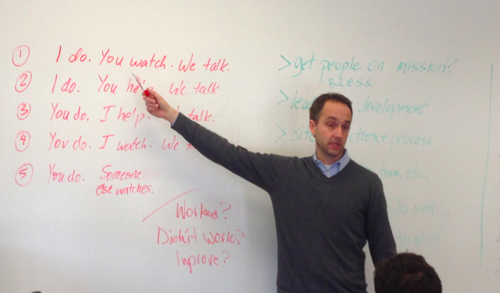
A couple of weeks ago I enjoyed a back-to-back connections with three very different and very fruitful ministries. On Monday, I was in Chicago with Dave and John Ferguson on the Community Christian Church team. On Tuesday I was with Mountain Lake Church in Atlanta, and on Wednesday I was with Upward Sports in Spartanburg, South Carolina.
These ministries demonstrate dramatic success. Dave and Jon have built a city-reaching, multi-site church as well as a church planting network (New Thing) around the defining value of "reproducing at every level". Shawn Lovejoy has lead a unique and effective church in the shadow of Andy Stanley's North Point Community Church. (In addition, he has encouraged a tribe of church planters through the ministry of churchplanters.com.) Both churches gather thousands of people weekly. Upward, as a sports ministry, has impacted millions and continues to cast mind-stretching vision to reach millions more.
My time in reflection on these ministries brought these observations:
#1 The unexamined vision is not worth casting.
When these leaders talk about what God is doing in their ministries, you can feel the ownership and passion that comes through the constant seeking, wrestling, deciding and articulating work of clarity. When they cast vision its real and its worth something not only because they sought God for it, but because they work for it.
#2 The more fruitful your ministry, the more time will be required—not less—to cultivate further clarity.
Great leaders know a simple fact: You can always be more clear. Most pastors treat a clarity exercise or vision retreat like its a one-time gig. But when you are around leaders who see crazy fruitful results, you'll notice a certain and constant preoccupation with clarity. Ironically they are spending disproportionately more time doing things like:
- keeping the mission real and felt
- making the values active and visible
- insisting that strategy is sharp and aligned
At Upward the team always jokes about re-entering "the tunnel of chaos" as part of the constant clarity pursuit. At CCC, Jon Ferguson, on moment's notice, can unpack the nuances of applying the 5-step process of reproducing at every level (pictured above.)
#3 Strategic assumptions and the strategy itself (that brought success) must be reinterpreted, reevaluated and reformulated every step of the way.
You don't convert and develop people the same way at each phase in your ministry. Why not? First, because there is always room for improvement. Second, because times and people change. Third, because with success, your organization must adapt and expand how it does what it does. If you want to keep things both sophisticated and simple, you must dedicate serious time to dialogue and rethinking as a leadership team. At Community Christian I enjoy watching Dave Ferguson redraw the map of how they planned to reach Chicago. As the picture changed, so did the strategy. Currently they are reconsidering how to decrease the number of campus constants as they expand beyond their current twelve locations.
#4 A big vision is the natural byproduct of consistent passion for a simple mission over a long time.
These three ministries didn't start with a big vision. The started with passionate mission. Over time, the stick-to-it-ness of humble tenacity and mission clarity gives way to bigger and bigger dreams that become apparent as the mission moves forward. Caz McCaslin recalls the dream to extend his gymnasium to reach another 100 kids. Why? His mission was to introduce children to Jesus through sports. Eventually that mission would bring the dream of 1,000 church gyms with evangelistic basketball leagues across the country. He accomplished that years ago. What next? The same mission is generating a plan to win 4 million kids. These "upsized visions" could never be seen or achieved without a fanatical focus on the same mission over time. The same is true with CCC. After becoming a multisite with twelve campuses Dave and Jon are now talking about "the how" of 200. They just wouldn't have see that fifteen years ago.
Which one of these lessons intrigues you the most?
